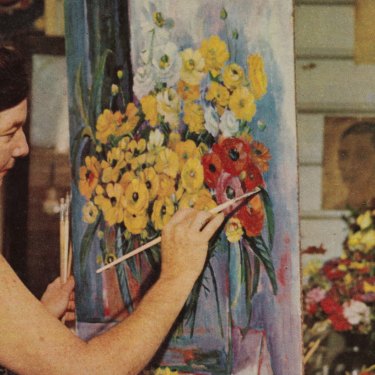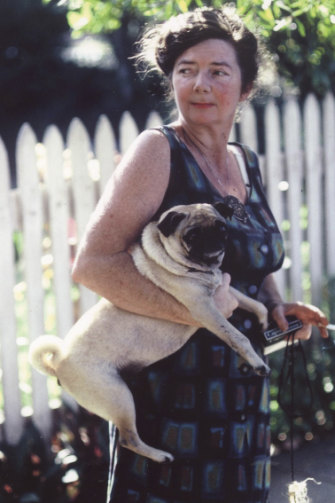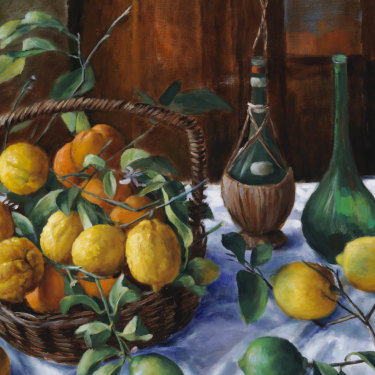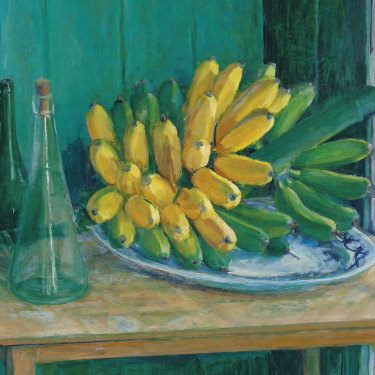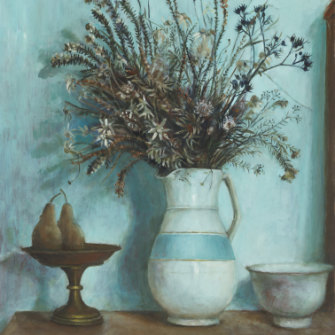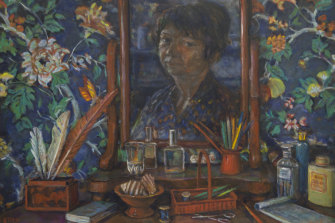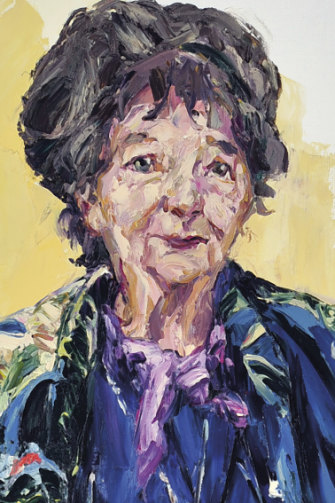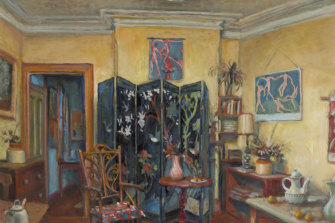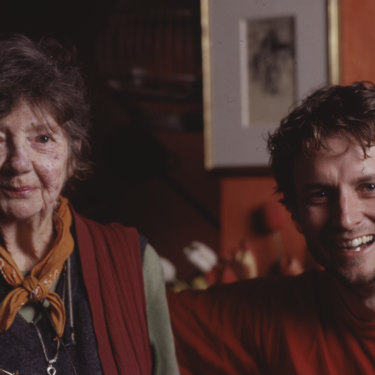Dame Quentin Bryce celebrates Margaret Olley’s ‘art of the everyday’
In Brisbane we always believed that Margaret Olley belonged to us. No matter where she travelled, where she settled, we knew that this subtropical city of fragrant and colourful jacarandas, poincianas, frangipanis and allamandas was held in her heart.
It is where her precious gift as a painter began to emerge, to be nurtured and encouraged; where her deeply loved family lived in the expansive weatherboard historic Queenslander named Farndon, with space for aunts, cousins and masses of friends who came to stay. Her mother Grace offered hospitality in spades, the stuff of legend. The oak dining table was loaded with enormous roasts, huge dishes of vegetables, then delicious puddings.
Margaret Olley painting at Farndon, 1966. Credit:Photograph: Bob Millar.Courtesy State Library of Queensland
Close friend Pamela Bell, the poet, described Farndon's sitting room as one of the most beautiful she had ever seen; its chintzes worn and mended and eclectic furniture were gathered from relatives and Olley's years in the antique business with brother Ken at Stones Corner.
Every time she came back Margaret felt she was coming home. What we felt was love, a gentle familiarity and true delight in her work. We recognised and understood her contribution to beauty, the art of the everyday and the poetry of objects. She shared her life with us from wherever she made her studio, the landscapes, portraits, architecture, murals, panoramas, interiors, the view from her window.
For me, it has always been the flowers that are Margaret, that evoke the most tender emotions; heart skipping and breathtaking. Their colour and light, rich sensuality and naturalism. With calm composure, the restraint of quinces lying on a plate. Lush and sensuous, the sheer joyousness of ranunculus jammed in a jar.
Our finest art writers have captured in lyrical description the gorgeousness of the niche she made her own: still life. Beauty connecting artist and viewer in a unique way. Margaret has been documented and recorded at great length. She bemused, inspired and tickled pink skilled observers who delved into the personal, searching to distil those reassuring and endearing qualities admired and respected by her fellow Australians.
The appeal of her dry humour, acerbic asides, confronting candour, self-effacing whimsy, her kindness, compassion, generosity — many have sought to know what it was that brought this artist into our hearts. Something I saw for myself, again and again, in the street and in our galleries, was that universal fondness for her. "There's Margaret Olley," they would say, with a nudge, a smile, a flicker in their eyes.
I viewed my first Olleys in the 1950s at the Johnstone Gallery, then located in the Brisbane Arcade in the city. I went there with my mother on our special expeditions to town, just the two of us. There was a pattern to those memorable trips. We would start at Allan and Stark for cosmetics, then down to the Penny's Building to see milliner Kath Dahl about hats. Next, fashion designer Gwen Gillam in the Arcade for a new dress, a silk cocktail frock, flower at the neckline – probably for show week.
Cane farmer's house (North Queensland) 1955 by Margaret OlleyCredit:University of NSW Art Collection
My mother would speak to me quietly about the contemporary Australian paintings. They were so different from the traditional English reproduced prints of Flatford Mill and other John Constables we had at home.
Some have described Brisbane as a cultural wasteland during the 1950s and 1960s. I don't remember it like that as I reflect on those years. It was certainly not sophisticated or cosmopolitan, but we were reading Patrick White. Many homes were filled with music — piano, violin, singing. There was probably more music in schools than there is now, and more art too, with wonderful artist teachers like Betty Quelhurst at my own.
There's Margaret Olley, they would say, with a nudge, a smile, a flicker in their eyes.
I soaked up the charm, sparkling exchanges of ideas around tables under little lamps at the Old Vienna while handsome, Hungarian-born Igor Wollner and bewitching Czech Magda, who had made Brisbane their home in the late 1940s, served delicious European food, new tastes. My mother and I had black forest cake with our coffee, mine iced with lashings of cream. We would recognise faces there: orchestra conductor Rudi Pekarek, art critic Gertrude Langer, architects Maurice Hurst and Robin Gibson, Margaret's good friend the designer Ron Sabien and her mother Grace Olley. In my teens and twenties, it was where I gleaned the magic and wonder of the arts, where I made friendships of enduring influence.
When I was visiting the Johnstone Gallery, Margaret was in Europe, falling in love with Vermeer, Cézanne, Vuillard, Morandi, Bonnard and others. She had adventures galore, discovering Paris, sending home pen-and-ink studies to Brisbane, monotypes, watercolours from Cassis, Venice, Concarneau, Versailles. Excursions with boon companions, hitchhiking with Margaret Cilento. Halcyon days.
How could I ever have imagined that 50 years later I would open an exhibition of some of those works by Margaret at the University of Queensland, my alma mater. Every Brisbane art lover was there, wanting to be close to Olley, for a word. I marvelled at her stamina and I was touched when she gave me the blue box holding the magnificent book of painted woodblock prints by Cressida Campbell, there with her.
Veteran art critic John McDonald wrote at the time, there was "nothing any critical review could add or subtract from the reputation of Margaret Hannah Olley".
A little later I was invited to Margaret's Duxford Street home, in Sydney, for tea. Her publicist, Philippa Drynan, was sent to the patisserie for lemon tarts. English breakfast tea was poured into fine but chipped willow china cups, glasses set out for ginger beer replete with a soft layer of fine dust. Oh, the comfort of the chintz chair from where I absorbed the wonderments of the famous Yellow Room. Schubert on the radio in the background.
Margaret Olley and her pug Bonnie Sue at Farndon 1970Credit:Courtesy of Christine France
Long-time director of the Art Gallery of New South Wales, Edmund Capon, called in with a bouquet of brightest flowers. Author and academic Ross Steele came with a string bag of groceries. Comings and goings there were legion. Barry Humphries, Ministers of the Crown, wits, sages and would-be novelists, curators and emerging artists.
Margaret was forthright and direct. I followed her lead and asked her about what always interests me most about a person, those early years that make us who we are. I wanted to learn more about what was written of her idyllic early childhood on the Tweed River. Rambling in long grasses, camping in little tents, languid summers at the beach, messing about in boats, picnics, rainstorms on the tin roof, seductive blooms, intoxicating smells. The "green, green, green" she loved, the sound of busy dragonflies.
I recounted my family's trips there in our black 1938 Oldsmobile during Christmas holidays at Surfers Paradise. We used to buy sweet little pineapples to scoop out, and paper bags of peanuts boiled in their shells.
We spoke of the hardships for her of leaving those carefree years behind for Brisbane, for boarding school at Somerville House. There she discovered her love for art, through the incredible luck of having a fantastic artist teacher, Miss Caroline Barker, who set her on her life's journey.
It is an afternoon I have stored in my treasure box of memories. A little in awe, I was conscious of the status attached to Margaret: the National Treasure, the icon, her accolades, the public recognition that had come with the 1990 retrospective at the S.H. Ervin Gallery and Christine France's monograph.
But at the same time, I felt I had known her forever. In a way I had. I followed her from the Brisbane Arcade to Bowen Hills when Brian and Marjorie Johnstone took the unusual step of moving their gallery to the suburbs and to their Queenslander timber home at 6 Cintra Road. I loved to go there, especially to Sunday morning openings — the Jatz crackers, the joie de vivre, the beautiful people. Art lovers and collectors Murray and Gillian Elliott (Jill only wore white or cream), art couple Roy and Betty Churcher, artists Joy Roggenkamp, Pam Wilson, John Rigby, Len and Kathleen Shillam, Nancy and Peter Underhill, informed critic "Gertie" Langer and Igor and Magda Wollner.
Bonnie Sue (1964) by Margaret OlleyCredit:Tweed Regional Gallery
Brian identified a solid group of artists who became household names: Charles Blackman, Arthur Boyd, Ray Crooke, Robert Dickerson, Russell Drysdale, Sidney Nolan, John Rigby, Gordon Shepherdson.
Olley in 1962 notched up a record £3000 in sales there. Brian Johnstone said: In the twelve years of running this gallery I have never seen such an outpouring of truly magnificent paintings. No other Australian artist has such a command of colour.
In her 1970 exhibition, she introduced interior paintings for the first time. Twelve large works were based on the interiors of Farndon, featuring bright fabric cushions from Ron Sabien's decorating shop and mementos from her travels with Donald Friend.
Her last show at the Johnstone in 1972, Homage, painted in artist David Strachan's house, was a moving tribute to her close friend killed in a car accident. In his brilliant book, Barry Pearce opined that Strachan "influenced Olley above all others — maybe the only one whose influence is discernible".
1972 marked the end of an era for Brisbane — the Johnstone Gallery closed. What great good fortune it was for our city that a 25-year-old Philip Bacon was then putting together plans for his new independent venture as an art dealer in Arthur Street, Fortitude Valley. He was keen to promote the legacy of reputable artists in Brisbane who had exhibited with the Johnstones. Brian encouraged and supported him in this, and Philip went to Sydney to meet Olley.
"She was scary, but she liked the idea of giving a young person a go," he told me. A strong theme in her later years.
Lemons and Oranges (1964) by Margaret OlleyCredit:Queensland Art Gallery/Gallery of Modern Art
In 1975 we were stunned by her first exhibition there. The glory of every one of the paintings, displayed on walls in colours carefully chosen by the artist. Exquisite compositions, unforgettable still lifes. Cinerarias, flannel flowers, plums and zinnias. Every one sold before opening. Everyone wanted one. Then, every second year after that, there was another Olley exhibition. Invitations were highly prized.
In 1989 a huge crush of people saw Margaret's first paintings of the Yellow Room. It had been blue until then. Yellow signified the beginning of an extraordinary fascination with the room's myriad contents. Margaret's gear and tackle and trim.
On a Sunday in late July 2011 — one of those soft, Sydney winter days — my husband Michael and I found ourselves in that same room. We took a picnic basket over to Margaret's, packed with tidbits we thought she would enjoy. Philip was there. He told me that Margaret was on a mission, putting last touches to paintings for her coming September exhibition. We set about unpacking food and forks, and the pale narcissi I had gathered suffused the sitting room with perfume.
Canvases, about 30 of them, took up every space, covered every surface. Four of us squeezed right in at one end of the oak table. One had a cigarette, two a glass of champagne, the fourth a slight disdain. In our midst, stems of early palest peach blossoms soared up into the skylight. Intimacy, affection, togetherness.
Bananas from the Garden, Farndon, 1974-5 by Margaret Olley.Credit:Tweed Regional Gallery
Our talk winding in and out — art, music, mice and men, the gorgeous Ethel Carrick and E Phillips Fox exhibition at the Queensland Art Gallery. I passed on the gallery's delight in Margaret's gift of a heavenly Ethel Carrick beach painting, given on the eve of the opening. "Oh, they liked it did they?" she asked, with that dreamy slight-surprised expression — part of her repertoire of beguiling charm.
Margaret Olley'sHawkesbury wildflowers and pears c.1973Credit:National Gallery of Australia
Philip was told to get out the Picasso intended for our National Gallery in Canberra. I felt a little nervous as it was passed around like a sheet of old tissue.
These were preliminaries to a sensitive question. How did Margaret want to be remembered? We tossed around the places, the museums, the galleries she truly loved. She was always deeply committed to the regional. There was no awkwardness, no unease. There was a seriousness of purpose. As I put my hand over hers, I observed on her face a paler cheek, a transparency I thought, a difference in her from last time.
We moved on. We held up each painting, compositions we know and love. She had been working furiously. There was some finishing still to do. Time to go. Hugs and kisses. As I stepped out into the courtyard, the ferns, the cyclamens, afternoon light cast shadows on our backs. I closed the gate on that magical encounter. I knew I would not see its bright star again.
Next day, Philip and Margaret measured up for the framer. The catalogue was in proof. Philip went home to Brisbane, and Margaret to her nest, with that contentment she found in her later years, a calmness in being on one's own. Her settling in, assured by Philippa, bringing down her tea, sharing a last cigarette.
On the following morning, Margaret's death was reported on the front pages. Every tribute was marked with admiration, respect and, yes, love. There was something uplifting in the sadness and loss felt across our country. So many words of gratitude, recognition of a golden life.
As I put my hand over hers, I observed on her face a paler cheek, a transparency I thought, a difference in her from last time.
A few months later, in March 2012, I opened the exhibition of paintings Margaret had been working to finish at feverish pace at the close of her life. It took my breath away as I walked in. At the front, outrageous pink, yellow, orange, red, Iceland poppies, ranunculus. Further into the gallery were the subtle, quieter banksias, pears in a wide silver dish. Sublime.
Looking back, I see that Margaret gave everything she had to that show, feverishly determined to have the collection to Philip on time. She found it hard to leave one painting for the next, seldom satisfied that it was "perfect".
Bedroom Still life by Margaret Olley (1997)Credit:Maitland Regional Gallery
Exhausted, she was forced to rest, including some days in hospital. Sitting by her bed there I was struck by her appearance, the cheekbones captured in every portrait, long dark, curling hair to her shoulders and chest. Adele Horin described the way Olley aged in a newspaper article, "The true face of artistic beauty": It may be helpful to keep in mind what turns out to be important in life – it is not looks but how one lived. It is not caring over-much about oneself but doing a lot for others. Relationships and work matter. Margaret Olley's amazing life and amazing face are a testament to true beauty.
In 15 March 2014, at the close of my Canberra, Yarralumla years, I went back to the Tweed. A perfect summer's day, not a cloud in the sky until little puffs formed about 2pm over the elegant Tweed Regional Gallery on the edge of Murwillumbah. Hundreds gathered in excitement and anticipation for the opening of the Margaret Olley Art Centre. A magic recreation of her home studio in Duxford Street, dining room, kitchen and the so-called Yellow Room — a perfect legacy for the artist who captured our imagination like no other.
Detail of Olley (The Tweed portrait), 2017, by Nichoias HardingCredit:Tweed Regional Gallery
Margaret wanted to be remembered by a significant investment in an art museum "where my childhood began". Her wish has been translated superbly at the gallery. Elegant modern architecture looks out across the Tweed River and the valley to majestic Mount Warning.
Set in the green, green, green of the dairy paddock given by Doug and Margot Anthony. Cows graze in picture-book calm on their farm over the fence.
The director of Tweed Regional Gallery, Susi Muddiman, was keen to ensure visitors viewed Margaret's paintings before seeing the Yellow Room and the Hat Factory. She certainly achieved her purpose. Two colours. Two walls. One terracotta, one the softest shade of blue, to enhance in the most exquisite way the palette of the paintings on loan. Tears fell as I stood in wonder. I was overwhelmed. Red apples, proteas, pears, daisies, marigolds, delphiniums, hippeastrums, lupins, gum blossoms … My heart was pounding.
Yellow Room with Screen, night, C. 1998, by Margaret OlleyCredit:Private Collection
And then a few steps and there it was, the studio and its contents: the Degas drawings, the Morandi etchings, Toulouse-Lautrec, Matisse on the left, burnished kilim rugs under foot, skirted lampshade, heads of Buddhas, waxed fruit in wide dishes, jugs of gently faded poppies on the chest of drawers, the chintz-covered chair that I sat in. So much to contemplate, bunches of flowers in various stages of decay, mountains of stuff, cobwebs and a subtle coat of dust on most things, ginger jars, ornaments from everywhere reassembled. Piles and piles of ribbons, classical music from a tiny radio and one of those hats she used to wear.
Margaret Olley was a mentor to Ben Quilty, pictured together in 2005. His portrait of Olley won the 2011 Archibald Prize.Credit:Fairfax Media
Chaotic at first glance, but as Christine France has noted "it was actually very planned", emphasising the importance of preserving the material, the continual treasure chest of delightful objects.
The painstaking and exacting process of cataloguing and photographing, archiving and packing up Margaret's home and studio took more than two years. The result is a triumph. One steps into a three-dimensional catalogue showing decades of arranging, looking and careful observation.
As the opening plaque was revealed, a gentle glorious cascade of paper flowers was released from nets — Margaret's favourites softly falling over us all.
Her life was a celebration of art, beauty and love.
Quentin Bryce's essay appears in the Queensland Art Gallery | Gallery of Modern Art's (QAGOMA) publication Margaret Olley: A Generous Life, which accompanies the exhibition of the same name which runs until October 13. The former Governor General and gallerist Philip Bacon will take part in a panel discussion about the beloved artist on Saturday, June 15 at the gallery at 11.30 am.
Source: Read Full Article
